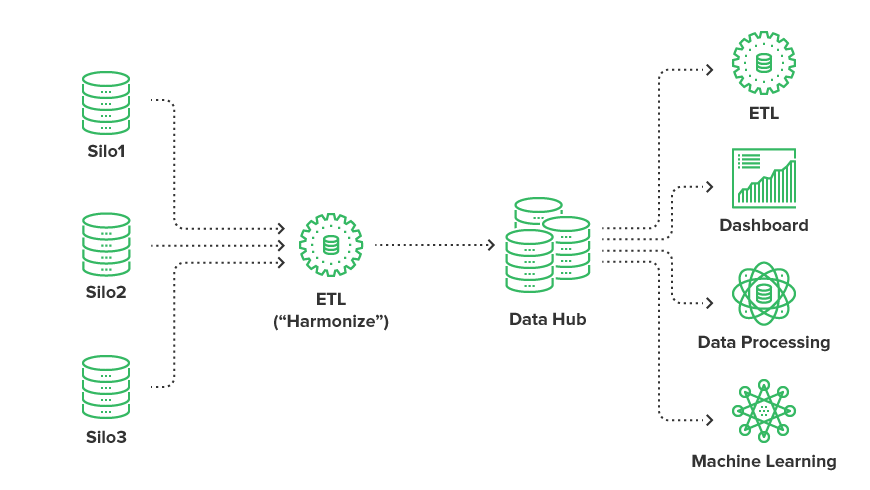Data and analytics strategies are integral to all aspects of digital business, according to Gartner. After all, understanding data enables the adoption of technologies that drive better business outcomes.
To become truly data literate, you need an enterprise data architecture—a combination of policies, standards, and data storage options like data lakes, warehouses, and hubs.
And yet, unlike data lakes and data warehouses, data hubs aren’t focused on the analytical use of data. Nor do they store data for long periods of time.
So why is it that 46% of data and analytics leaders use them? Let’s take a closer look.
What is a Data Hub?
A data hub is a centralized system for data storage, definition, and delivery. It’s a hybrid of a data lake and a database warehouse, as it provides a central repository for your applications to dump data.
The hub functions as a management point, enabling you to see how data flows across your enterprise. It collects and shares data in a variety of formats for more accessible insights.
Now that we’ve defined what a data hub is, let’s dig into its benefits.
What are the benefits of a Data Hub?
Gartner
If you have multiple storage solutions for your data, it becomes difficult to access. As such, you’re not getting the valuable data insights you need for your business.
A data hub is a centralized location that sends data from siloed locations directly to your business applications. This provides a number of benefits.
1. Better data visibility
A data hub filters and indexes all types of data from other sources. This means users can access information and gain insights more quickly than with a data lake or warehouse.

2. Fast data delivery
Gartner analyst Andrew White likens a data hub to a busy subway system. It’s an apt metaphor (up to a point). The stations are applications where you process the data, while the lines are forms of integration, such as an ETL pipeline.
That said, anyone who takes the subway knows how chaotic it can be, and this is where the metaphor breaks down. Rather, think of a data hub as a traditional hub-and-spoke model. Data flows between it and various endpoints and applications in real-time, with no delays.
3. Improved data security
To ensure the security of your critical information, you should implement Identity and Access Management (IAM) controls. But the more databases you have, the harder it is to track who is accessing your data.
With a data hub, you can:
- Implement and manage data access controls from a centralized location.
- View who accessed data, as well as what data they accessed.
- Access all data from one place so you can comply with data governance more easily.
4. Real-time updates
Payment apps and sites that process claim information can benefit from using data hubs as it allows for instant updates. This means you can complete transactions in real-time, enhancing the customer’s experience.
5. Data-driven insights
A data hub connects data sources and consumers. As a result, you can gather information that helps you make better business decisions and understand what makes your customers tick.
6. More accessible resources
Using a data hub for storing resources means they are more easily accessed by everyone in your organization.
And yet, a data hub is not the answer to all of your data challenges. As much as it has its advantages, it has its share of pitfalls too.
What are the disadvantages of a data hub?
Yes, a data hub can provide fast insights. And yes, it provides a centralized location for easier access to resources. But there are some areas where it falls short.
For one thing, it has limited analytics capabilities. As a result, it’s slow when dealing with complex queries and unsuitable for processing historical data. Then there’s the fact that it’s not able to store large amounts of data.
Moreover, the ETL processing within a data hub is for indexing the data, not mapping it into a strict structure. As such, it’s not a solution in itself, but rather as part of a larger enterprise architecture.
Build the right architecture for your business
A data hub makes it easier to understand some types of data for faster business insights. But to be truly data literate, you need a complete enterprise architecture with data integration software to give your data structure.
Discover more about the data architecture options available to your business by reading our Guide to Enterprise Data Architecture.
Your guide to enterprise data architecture
By CloverDX
CloverDX is a comprehensive data integration platform that enables organizations to build robust, engineering-led, ETL pipelines, automate data workflows, and manage enterprise data operations.







